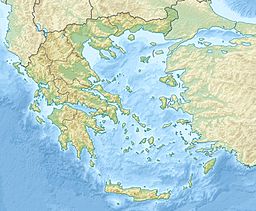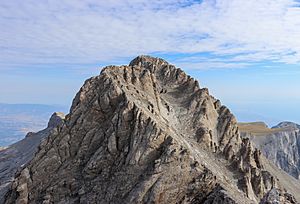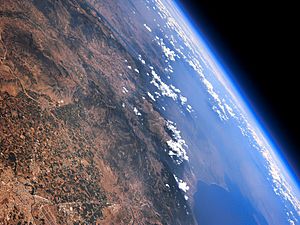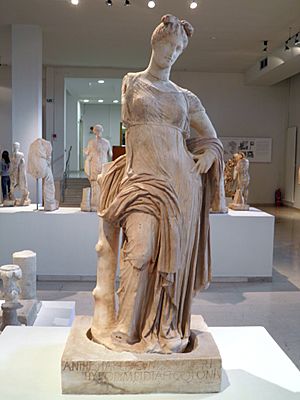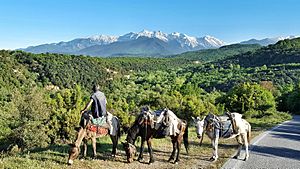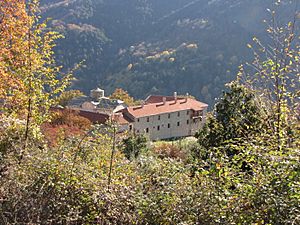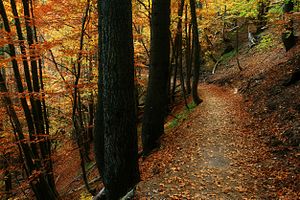Mount Olympus facts for kids
Quick facts for kids Mount Olympus |
|
|---|---|
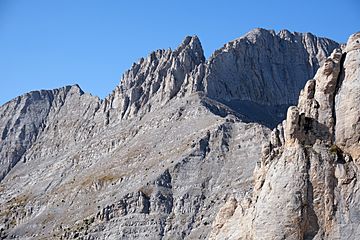
Mount Olympus' peaks in daytime
|
|
| Highest point | |
| Peak | Mytikas |
| Elevation | 2,917.727 m (9,572.60 ft) |
| Prominence | 2,353 m (7,720 ft) |
| Parent peak | Elferkofel |
| Listing | Country high point Ultra |
| Geography | |
| Parent range | Thessaly and Macedonia, near the Gulf of Salonika |
| Climbing | |
| First ascent | By religious pilgrims or priests in Antiquity. First Modern Ascent: 2 August 1913 Christos Kakkalos, Frederic Boissonnas and Daniel Baud-Bovy |
Mount Olympus ( Greek: Όλυμπος, romanized: Ólympos) is the tallest mountain in Greece. It's part of a large mountain group near the Aegean Sea. You can find it between Thessaly and Macedonia, about 80 km (50 mi) southwest of Thessaloniki.
Mount Olympus has 52 peaks and many deep valleys. Its highest peak is Mytikas (Μύτικας Mýtikas), which means "nose." It stands at 2,918 meters (9,573 ft) tall. This makes it one of the highest peaks in Europe when you consider its height above the surrounding land.
In Greek mythology, Olympus was believed to be the home of the Greek gods, especially on the Mytikas peak. The mountain is also famous for its amazing variety of plants and animals. It became Greece's first National Park in 1938. It is also recognized as a World Biosphere Reserve.
Olympus is a very popular place for hiking in Greece and across Europe. There are mountain shelters and many climbing paths for adventurers. Most people start their journey from the town of Litochoro, which is at the base of the mountain. Litochoro is about 100 km (62 mi) from Thessaloniki.
Contents
- What is Mount Olympus Like?
- How Was Mount Olympus Formed?
- What Do the Peaks Look Like?
- The Name and Myths of Olympus
- A Look at Olympus's Past
- What is the Climate Like?
- What Plants Grow on Olympus?
- What Animals Live on Olympus?
- Olympus National Park: Protecting Nature
- How to Get to Mount Olympus
- Mountain Shelters on Olympus
- Olympus on a Coin
- See also
What is Mount Olympus Like?
The shape of Mount Olympus was created by rain and wind over many years. It stands like a tall tower, almost 3,000 meters (9,843 ft) above the sea. The sea is only 18 km (11 mi) away from Litochoro.
Olympus has many peaks and is almost round. It measures about 80 km (50 mi) around and covers an area of 500 square kilometers (193 sq mi). To the northwest, you'll find the village of Kokkinopilos. Other villages like Petra, Vrontou, and Dion are to the northeast. The town of Litochoro is on the eastern side.
The dry lower parts of Olympus are covered in chaparral plants. Wild boars live here. Further east, the plain of Dion is very fertile. It gets water from streams that flow down from Olympus.
How Was Mount Olympus Formed?
Mount Olympus is made of sedimentary rock. This rock was formed 200 million years ago at the bottom of a shallow sea. Over time, big geological events pushed the entire region and the sea upwards.
About one million years ago, huge glaciers covered Olympus. They carved out its flat areas and dips. As the Earth warmed, the ice melted. The water carried away crushed rocks, forming large fan-shaped deposits called alluvial fans. These spread out from the mountain's base all the way to the sea. You can learn more about the mountain's geology at the Geological Museum of Mount Olympus in Leptokarya.
What Do the Peaks Look Like?
The complex history of the region is clear in the shape of Olympus and its National Park. It has deep valleys and many smooth peaks. Many of these peaks are over 2,000 meters (6,562 ft) high. Some examples are Aghios Antonios (2,815 m or 9,236 ft), Kalogeros (2,700 m or 8,858 ft), and Profitis Ilias (2,803 m or 9,196 ft).
However, the most striking features are the central, almost straight-up, rocky peaks. When you look from Litochoro, the mountain looks like a "V" shape. The left side is Mytikas, Greece's highest peak. On the right is Stefani (also called Thronos Dios, or "Throne of Zeus"). Stefani is 2,902 meters (9,521 ft) high and has the most impressive, steep face on Olympus. Its last 200 meters (656 ft) are a big challenge for climbers.
Further south, Skolio (2,911 m or 9,551 ft) is the second-highest peak. It forms a wide curve with steep slopes on its west side. This creates a huge, bowl-shaped area called 'Megala Kazania,' which is 700 meters (2,297 ft) deep. On the east side of the high peaks, there are parallel folds called 'Zonaria.' Even narrower, steeper paths called 'Loukia' lead to the peak.
To the north, between Stefani and Profitis Ilias, is the Muses' Plateau, at 2,550 meters (8,366 ft). Further south, in the middle of the mountain, is the alpine tundra area of Bara, at 2,350 meters (7,710 ft). Olympus has many ravines and gullies. The Mavrologos-Enipeas ravine is 14 km (9 mi) long, and Mavratzas-Sparmos is 13 km (8 mi) long. These cut the mountain into two oval parts.
On the southern foothills, the Ziliana gorge is 13 km (8 mi) long. It acts as a natural border, separating Mount Olympus from Lower Olympus. There are also many cliffs and caves, some of which are still unexplored. The rocks allow many springs to form, mostly below 2,000 meters (6,562 ft). There are also small seasonal lakes, streams, and a small river called Enipeas. It starts at Prionia and flows into the Aegean Sea.
The Name and Myths of Olympus
No one knows for sure where the name Όλυμπος (Olympos) came from. One idea is that it means "pure foot." This fits with ancient descriptions of the Earth as a footstool for heaven, where the gods lived. Another idea is that the word is very old, from before Greek, and simply meant "mountain."
In Ancient Greek religion and mythology, "Olympus" was the home of the Twelve Olympian gods. Greeks believed it was a very tall mountaintop. In areas settled by Greek tribes, the highest local mountain was often called Olympus.
The Olympus in Thessaly is the highest peak in any Greek-settled land. By the 5th century BC, it was seen as the main "Pan-Hellenic" (all-Greek) home of the gods.
In Pieria, at the northern base of Olympus, myths say the nine Muses lived. They were the goddesses of the arts and daughters of Zeus and the Titaness Mnemosyne.
A Look at Olympus's Past
In ancient times, the Olympus mountain range was the border between Thessaly and Macedon. Its history is linked to the rise of Macedon and wars from the 4th to 2nd centuries BC.
During the Ottoman Empire (nearly 400 years), the mountain was a hiding place for klephts (local fighters) and armatoloi (armed groups). It was known as Semavatevi in Turkish.
In the early 20th century, even after Greece gained freedom from the Ottomans (1912), robbers were active here. The most famous was Giagoulas. During the German invasion in 1941, the Hellenic Army fought important battles here. From 1941 to 1944, Olympus was a center for the Greek Resistance. Later, the Greek Civil War (1946–49) began in Litochoro.
Ancient and Medieval Sites Near Olympus
The whole area around Olympus in Pieria is an archaeological and historical site. This helps protect its ancient and historical importance.
Five kilometers (3 mi) from the sea is Dion. This was a sacred city of the ancient Macedonians, dedicated to Zeus and the Twelve Olympians. It was a thriving city from the 5th century BC to the 5th century AD. Digs since 1928 have found many items from Macedonian, Hellenistic, and Roman times. Today, there's a unique archaeological park with the ancient town and sacred worship places. Many statues and valuable items are kept in the nearby Dion's archaeological museum.
Pimblia and Leivithra, two other towns in the Olympus region, are linked to Orpheus. He was a famous musician and poet in Greek myths. He was said to have taught the secret ceremonies of worship for Dionysus here.
By the sea, in a key location, is Platamon Castle. It was built between the 7th and 10th centuries AD in the ancient town of Heracleia. To the north is ancient Pydna. A major battle between the Macedonians and Romans happened here in 168 BC.
Christian Monuments on Olympus
The Olympus region also has several Christian sites. One is the highest chapel in Orthodox Christianity. It is dedicated to Prophet Elias, who is often linked with mountaintops in Greek tradition. This chapel is on the peak of the same name (Profitis Ilias), at 2,803 meters (9,196 ft).
It was built in the 16th century by Saint Dionysios of Olympus. He also founded the most important monastery in the area. The Old Monastery of Dionysios (820 m or 2,690 ft) is in Enipeas' gorge. It was destroyed by the Germans in 1943 during World War II. Today, it is partly restored and is part of the New Monastery of Dionysios outside Litochoro.
Climbing Mount Olympus
Ancient records show that people regularly visited Mount Olympus for religious reasons. For example, ancient Greek pottery and coins from 400 B.C. have been found on the summit. Writers like Plutarch and Augustine of Hippo mentioned that items left on the summit remained untouched by weather. This led them to believe the highest mountains were above clouds and winds.
The third highest peak, Agios Antonios (2,817 m or 9,242 ft), was once a sanctuary for Zeus. This was confirmed by discoveries in 1961.
In more modern times, explorers tried to reach the summit. However, it was not until August 2, 1913, that the highest peak of Olympus was finally reached. The Swiss climbers Frédéric Boissonnas and Daniel Baud-Bovy, along with a local wild goat hunter named Christos Kakkalos from Litochoro, made the first recorded ascent. Kakkalos, who knew Olympus well, was the first of the three to reach Mytikas. He became the official guide on Olympus until his death in 1976.
Climbing Mount Olympus is mostly a hike. Only the final part from Skala summit to Mytikas peak requires some rock scrambling. About 10,000 people climb Mount Olympus each year. Most of them reach only the Skolio summit. Many climbs start from Litochoro, which is called the City of Gods because it's at the foot of the mountain. From Litochoro, a road leads to Prionia, where the hike begins.
What is the Climate Like?
Olympus generally has a Mediterranean climate with some influence from the land. The weather changes depending on how close you are to the sea and the mountain's rough terrain.
In lower areas like Litochoro, summers are hot and dry, while winters are humid and cold. Higher up, it's more humid and can be severe, with strong weather. It often snows throughout winter, and rain or snow can happen even in summer. Temperatures in winter range from -10°C to 10°C (14°F to 50°F). In summer, they range from 0°C to 20°C (32°F to 68°F). Winds are common every day. Generally, the temperature drops by 1°C (1.8°F) for every 200 meters (656 ft) you go up.
The coastal northeast slopes get more rain than the northwest. This leads to more plants on the northeast side. August is the hottest month, and February is the coldest.
The highest part of the mountain, above 2,000 meters (6,562 ft), is covered in snow for about nine months (September to May). In some places, winds pile up snow 8–10 meters (26–33 ft) thick. Some deep ravines have snow all year round. The average temperature in this alpine region is -5°C (23°F) in winter and 10°C (50°F) in summer.
Rainfall varies from 149 cm (59 in) at Prionia (1,100 m or 3,609 ft) to 170 cm (67 in) at Aghios Antonios. About half of this is rain and hail in summer, and the rest is snow in winter. The weather can change many times in one day. In summer, rain is frequent, often as evening thunderstorms with hail and strong winds. Water springs above 2,000 meters (6,562 ft) are rare. Visitors should always carry water and suitable clothing for any weather.
What Plants Grow on Olympus?
Scientists started studying Olympus's plants in 1836. The National Park of Olympus is one of Greece's richest plant areas. It has about 1,700 different plant species and subspecies. This is about 25% of all Greek plants! Of these, 187 are very important, 56 are found only in Greece, and 23 are found only on Olympus.
A Swedish botanist named Arne Strid wrote an important book in 1980 about the plants and flowers from the Aegean Sea coast up to the high parts of Mount Olympus.
Most plants at lower elevations are common Mediterranean and central European types. Ramonda heldreichii, a plant that survived the Ice age, is very interesting to botanists. The varied landscape, different slope directions, and closeness to the sea create unique local climates. This, along with the geology, helps specific types of plants and habitats grow. The northeast side of Olympus is heavily forested because it gets the most rain. The southwest side has much fewer plants.
Plant Zones on Olympus
Olympus generally has four main plant zones. However, because the land is so complex and there are many small climates, these zones don't always form a clear line as you go up the mountain.
Mediterranean Plants (300-500 meters)
This zone has evergreen trees with wide leaves, like those found in maquis areas. You'll see oak (Quercus ilex), Greek strawberry tree, kermes oak, strawberry tree, bay laurel, and cedar. Some trees that lose their leaves, like ash, elm, and Montpellier maple, are also common.
Forests of Beech, Fir, and Conifers (500-1,700 meters)
The evergreen zone slowly changes into forests of European black pine. These pines grow in thick groups. On the northern slopes of the Xirolakos valley, between 600 and 700 meters (1,969 and 2,297 ft), there's a large forest of downy oak.
Black pine is common on the eastern and northern sides of the mountain, between 500 and 1,700 meters (1,640 and 5,577 ft). In this zone, you'll also find small groups of fir trees and Bosnian pine. Beech trees are also here. While beech forests are large in nearby mountains, on Olympus they are found in small groups, mainly in wetter areas with good soil. The Enipeas' gorge has a very rich variety of trees and shrubs. You can see elm, cherry plum, European yew, hazel, holly, manna ash, and maple. Gorges and ravines are covered by oriental planes, willows, and black alders.
Northern Conifer Zone (Above 1,000 meters)
The main tree in this zone is the Bosnian pine. This rare pine grows above 1,000 meters (3,281 ft) and slowly replaces the black pine. Above 1,400 meters (4,593 ft), it forms an almost pure forest. Above 2,000 meters (6,562 ft), the forest becomes thinner, reaching up to 2,750 meters (9,022 ft). This is one of the highest tree line limits in the Balkans and Europe. Another interesting thing about this zone is that above 2,500 meters (8,202 ft), the trees grow in a crawling, stunted form. This area is mostly dry and rocky. The plants here are adapted to these tough conditions. The flora includes many plants found only in the Balkans.
Treeless High Mountain Zone (Alpine Tundra)
Beyond the Bosnian pine zone, there's a large area without trees. This zone has alpine meadows with different types of grasslands. This alpine flora has more than 150 plant species. It includes meadows where snow collects, grassy swamps, and plants that grow in rocky cracks. Most of the plants found only on Olympus live in these meadows, rocks, and steep slopes. Half of them are found only in the Balkans, and 23 are found only on Olympus and nowhere else.
Plants Found Only on Olympus
Here is a list of 23 plants that grow only on Mount Olympus: Achillea ambrosiaca, Alyssum handelii, Asprerula muscosa, Aubrieta thessala, Campanula oreadum, Carum adamovicii, Centaurea incompleta, Centaurea litochorea, Centaurea transiens, Cerastrium theophrasti, Coincla nivalis, Erysimum olympicum, Festuca olympica, Genista sakellariadis, Ramonda heldreichii, Ligusticum olympicum, Melampyrus ciliatum, Ophrys helenae (Ophrys sphegodes subsp. helenae), Poa thessala, Potentilla deorum, Rynchosinapis nivalis, Silene dionysii, Silene oligantha, Veronica thessalica, Viola striis-notata, Viola pseudograeca.
What Animals Live on Olympus?
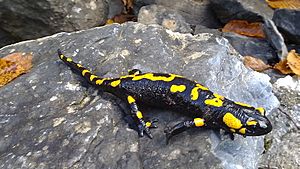
The animals of Olympus have not been fully studied yet, but there is a great variety of important, rare, and endangered species. Large mammals that used to live here, like deer, have disappeared. In ancient times, there were lions, and at least until the 16th century, there were bears.
So far, 32 species of mammals have been recorded. These include Balkan chamois, roe deer, wild boar, wildcat, beech marten, red fox, and red squirrel.
There are also 108 species of birds. Some examples are sparrowhawk, cinereous vulture, rock partridge, white stork, rock dove, European robin, lanner falcon, peregrine falcon, golden eagle, and hoopoe. Many of these, especially the birds of prey, are rare.
In addition, there are common reptiles (22 species like snakes, turtles, lizards) and some amphibians (8 species) in streams and seasonal ponds. There is also a wide variety of insects, especially butterflies.
Olympus National Park: Protecting Nature
Greece's highest mountain, the ancient home of the Twelve Gods, was the first area in the country to get special protection. It was declared a National Park in 1938. The goal was to protect the natural environment forever. This includes the wild plants, animals, natural landscape, and its cultural value. The park also aims to promote scientific research, teach people about the environment, and help tourism grow.
Special laws stop any kind of harmful activity on the eastern side of the mountain, in an area of about 4,000 hectares (9,884 acres). This is the core of the Park. A wider area around this core is called the "peripheral zone." Its management is done in a way that doesn't harm the core. Today, the park has grown to 24,000 hectares (59,305 acres).
Administratively, it belongs to the Pieria and Larissa regions. Its lowest point is 600 meters (1,969 ft), and its highest peak, Mytikas, is at 2,917.727 meters (9,572.6 ft). In 1981, UNESCO named Olympus a "Biosphere Reserve." The European Union has also listed Olympus as important for birdlife. It is part of the Natura 2000 European Network as a special protection area.
In June 2016, the Olympus National Park Information Center opened in Litochoro. It teaches visitors about the geology, ancient sites, mythology, monasteries, plants, and animals of Mount Olympus. Hikers can get help from professional rangers, and guides offer tours in the mountain area.
Rules for Olympus National Park
The Park is protected by special laws. Under the "Special Regulation," you can only enter the Park using existing roads. You can only travel on formed paths from sunrise to sunset. Visitors should also know that the following are not allowed:
- Children under 14 years old entering without an adult.
- Parking anywhere other than specific parking lots.
- Cutting trees, taking soil, pulling up shrubs, plants, or collecting seeds.
- Hunting any animal at any time of the year.
- Collecting or destroying nests, eggs, or chicks, or disturbing animals in general.
- Damaging geological formations (rocks, caves).
- Letting any animals you bring move freely.
How to Get to Mount Olympus
The Olympus mountain range is in the middle of mainland Greece. It's easy to reach by train on the Athens-Thessaloniki line. There are also smaller roads connecting towns and villages around the mountain. The main starting point for trips is the town of Litochoro, which has many hotels and restaurants. Along the coast of Pieria, there are also many campsites and places to stay.
The closest international airport is in Thessaloniki. Train stations are in Litochoro, Katerini, and Leptokarya. There are frequent bus services and a taxi stand in Litochoro's main square.
Mountain Shelters on Olympus
There are several mountain shelters (refuges) on Mount Olympus for hikers and climbers:
- Spilios Agapitos: This was the first shelter in the area. It's at "Βalkoni" (or "Exostis") at 2,100 meters (6,890 ft). It's in the center of Mavrologos and belongs to the Greek Federation of Mountaineering Club.
- Vrysopoules: This shelter is to the west, behind Mavratzas' gorge, at 1,800 meters (5,906 ft). You can also reach it by car from Sparmos. It has 30 beds, a kitchen, water, electricity, heating, and a fireplace. It's open all year, but you need military permission to stay overnight.
- Christos Kakalos: Located at the southwest edge of Muses' Plateau (2,648 m or 8,688 ft). It belongs to the Greek Federation of Mountaineering and Climbing. It's open from May to October, has 18 beds, electricity, blankets, a kitchen, and tank water.
- Stavros ("Dimitrios Bountolas"): This shelter is on the eastern side of Olympus, 9.5 km (6 mi) from Litochoro by road, at 930 meters (3,051 ft). It's in the Dionysios Monastery forest. It's open all year, mainly as a refreshment room and restaurant, and can host 30 people.
- Giosos Apostolidis: On Muses' Plateau (Diaselo – 2,760 m or 9,055 ft). It can hold 80 people and has electricity, water, a fireplace, and a kitchen. It's open from June to October.
- Petrostrouga: This shelter is on a common path to Muses' Plateau, at 1,900 meters (6,234 ft). It's surrounded by old Bosnian pine trees. It can host 60 people and has a kitchen, electricity, water, and a fireplace. It's open all year. It also has medical equipment and one of three emergency heliports on Olympus.
Emergency Shelters
- Aghios Antonios: This emergency shelter is on the Aghios Antonios summit (2,817 m or 9,242 ft). It has emergency supplies and wireless communication for emergencies.
- Kalyva tou Christaki: This emergency shelter is in "Megali Gourna" (2,430 m or 7,972 ft) along the Path E4. It only has beds and is meant for protection from bad weather.
- Kakalos: This emergency shelter is on the eastern edge of the Plateau of Muses at 2,650 meters (8,694 ft). It was named after Christos Kakalos, the Olympus hunter and guide who helped with the first climb to Mytikas in 1913. It can hold 25 people and offers lodging, food, and toilets. It's open from mid-May to the end of October and from December to mid-April.
The official list of shelters on Mount Olympus is kept by the Olympus National Park Management Agency.
Olympus on a Coin
Mount Olympus and its National Park were chosen as the main design for a special Greek commemorative coin minted in 2005. On the back of the coin, you can see the War of the Titans on Mount Olympus, along with flowering branches. Above the scene, it says "National Park Olympus" in Greek.
See also
 In Spanish: Olimpo para niños
In Spanish: Olimpo para niños


